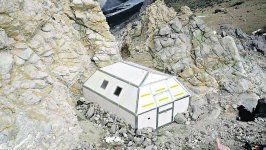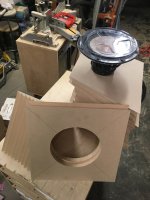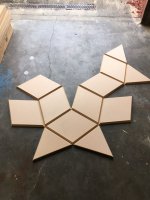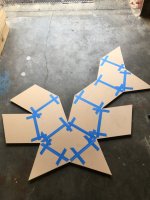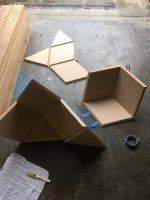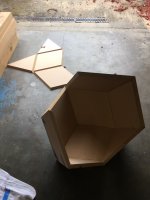Foam core works quite well - sort of like a modern "tonewood" in that it re-radiates a bit of sound and has built in dampening abilities. I added some internal panels with soft latex caulking to reduce the reverberation. This speaker actually sounded quite impressive.
It looks quite interesting, particularly to assemble them quite fast, but I don't know where could I find this foam-core in Brussels (A.K.A. "rathole", according to president Trump 😛) though, at a reasonable price.
Thanks for the suggestion.
...A standard closed box with standard stuffing sounded muffled and coloured in comparison.
Have a serious guess why that thing is happening and audiable, reason is very simple caused by hypercube internal volume is so limited that LF roll off is at a relative high point (see xrk971 graph post 560) where in a standard closed box we have more volume plus your stuffing adds virtual volume as driver can see so that its LF roll off is extended down in frq at least compared to hypercube, if you take that two enclosures outside where there is no more than one boundery the standard enclosure will probably not sound muffled anymore and will probably outcompete hypercube in bass area because of its lower extension, problem is in indoor enviroment we have room boundary reinforcement and room pressurization that is unique to each room and exactly positioning of speaker system and each time a limited narrow band of those non linear LF gains when summed with speakers natural roll off curve makes a boost instead of a cut or linear sum then bass area is ruined and sounds muffled or mayby a bit hard and cold and also music can loose its original rythm (foot tapping) because a minimum phase boost sum will advance (speed up) original timing. So the effect that hypercube have less internal volume and a higher frq point of LF roll off is the thing that makes it stay free and not collide with rooms nasty inverse boundary reinforcement and room pressurization curves but then don't expect very low frq linear extension because speaker is really not acoustic active down there but it should probably be no problem when used for playback of lighter music genres. Also hypercube verse standard box have probably a higher point in frq for baffle step loss and a cleaner diffraction curve which probably also in some way makes it sound a bit less muffled. Back in post 441 there is graphs that show about those room boundary reinforcement and room pressurization effect and also a link that point to used spreadsheet.
Last edited:
The attached sound clips will serve as a "virtual audition" of the Hypercube speakers as "heard" from the listening position of my room. They are the result of convolving music clips with the impulse responses of the system as measured from the listening spot (left channel of the clip convolved with the left speaker IR etc...). The impulse response has had a small amount of correction applied to it using DRC with a windowing size of 200ms @ 20hz - .2ms @ 20khz which is the correction strength I have been using while listening for a little while now. Anyone who has attempted to record and listen to the sound from their speakers (or any sound for that matter) already knows that in real life the room is not noticed as much as it is in the recording. Headphone use is recommended and crossfeed could be applied additionally for more realism.
Special thanks to a rockin' friend in the Netherlands for helping with the hosting. Clip no. 8 is for you 😉.
http://www.rsr-concepts.com/diyma/hypercubes convolved mp3.zip
Trying to listen to this on my iPad. Keeps asking me for a 4 digit pin?
Out of curiosity, what exactly would you expect to glean from listening to a sound clip on any mobile device, even with a good set of ear speakers, etc?
Thank you a lot Gmad for taking the time to reply also. As for the reason #1, since the square we are talking about would have a side of the smaller diagonal of the rhombus, the maximum theoretical diameter allowed for the design taking 25 cm for the side, would be about 29 cm.
And the largest "theoretical" diameter for a driver inscribed within the rhombus is about 23.5 cm, so the difference is there, but it is not that insurmountable, is not even 25 percent.
The reason #2 I do not fully get: you mean instead of having at the back the summit of a pyramid, it has a surface that is paralell to the one where the driver is mounted? And thus the backwave acts in a less interesting way? It cannot contribute to as many frequencies, because of this?
Sorry, I don't have a background in physics at all.
Has anyone tried the fully dodecaedron vs truncated dodecaedron to establish the differences?
So, as for reason #1, yes, it equates to using, say, a 10" driver instead of 8", while also getting an ~8% reduction in enclosure volume.
Reason #2 is a little more tricky, and involves the need to visualize the rhombic dodecahedron as 6 opposing pyramids (the bases of which form a cube, and the apexes of which would meet at the center of the cube if inverted, filling its space) rather than 12 opposing rhombi. When the RD is fully square truncated, one of the six pyramids is removed which exposes one of the faces of the inner cube. It was suggested that the faces of the cube (bases of the pyramids) are the planes where the air oscillates most freely (least pressure fluctuation), while the center of the cube (as well as the corresponding pyramid corners) are where the air is stiffest (most pressure fluctuation). Additionally, it was proposed that the opposing "pyramidal faces" support a continuous range of standing waves rather than a discrete set (along with the corresponding nulls) that might be expected from the opposing rhombic faces. A much more thorough explanation has been provided here by MK: Technology Briefing
Remember that this is just a theory propossed as an attempt to explain why an enclosure consisting almost entirely of equally spaced parallel surfaces (like a cube) acheives such good measured performance.
Hi White Fang (Pynchon?),
I built per Matthews original truncated dodecahedron with a Visaton B200, 5mm spruce plywood (no tonewood, though) and glued with Titebond hide glue.
Excellent result!
I have the pieces for the next iteration with 9mm plywood in preparation and will be able to tell if the thinner more resonating wood is worth it.
Best of luck,
Achim
Pictures please! 🙂
Trying to listen to this on my iPad. Keeps asking me for a 4 digit pin?
Those files were kindly hosted for me by wesayso (before I knew about dropbox). I have since posted something similar here: A convolution based alternative to electrical loudspeaker correction networks but the impulse responses were windowed (frequency dependent) to better approximate the sound as perceived in person. Also, these more recent files are demonstrating the sound with and without room EQ.
These "virtual demos" are not meant to be taken too seriously of course, but they are not completely useless either.
So, as for reason #1, yes, it equates to using, say, a 10" driver instead of 8", while also getting an ~8% reduction in enclosure volume.
Reason #2 is a little more tricky, and involves the need to visualize the rhombic dodecahedron as 6 opposing pyramids (the bases of which form a cube, and the apexes of which would meet at the center of the cube if inverted, filling its space) rather than 12 opposing rhombi. When the RD is fully square truncated, one of the six pyramids is removed which exposes one of the faces of the inner cube. It was suggested that the faces of the cube (bases of the pyramids) are the planes where the air oscillates most freely (least pressure fluctuation), while the center of the cube (as well as the corresponding pyramid corners) are where the air is stiffest (most pressure fluctuation). Additionally, it was proposed that the opposing "pyramidal faces" support a continuous range of standing waves rather than a discrete set (along with the corresponding nulls) that might be expected from the opposing rhombic faces.
OK, I am convinced, problem is I thought I only needed 12 times the same shaped piece... it turns out I need now 13 pieces, 3 different ones (8 rhombi, 5 triangles and a square) and two different assembly angles... not insurmountable, but just a little bit more complicated. If I recall correctly, since the pyramid we are truncating is like a sixth of the inner volume, turned around, the angle at which the square face and the 4 triangles meet requires a 45 degrees bevel, unlike the 30 degree one where the typical rhombi meets its neighbor. Please correct me if I am wrong.
I was thinking of trying this form as resonator for musical instruments consisting mainly of a box. I need to build a RhomDode Marimbula or Cajon (and as a bonus, it's easy to sit onto it, since the legs have two recesses for them)
Have a serious guess why that thing is happening and audiable, reason is very simple caused by hypercube internal volume is so limited that LF roll off is at a relative high point (see xrk971 graph post 560) where in a standard closed box we have more volume plus your stuffing adds virtual volume as driver can see so that its LF roll off is extended down in frq at least compared to hypercube
There may be sth to your thinking, but
the volume of my standard box was actually a bit smaller than the hypercubes'.
My feeling is that what I hear as coloration and muffle is the dampened sound created in the interaction of the chamber with the stuffing which gets out through the membrane of the speaker as well as creating comb filtering with the waves created by the speaker movement (=signal).
The unstuffed internal sound of the hypercube is a broadband smorgasbord of frequencies (just put your ear to the enclosure) which maybe interacts more benignly as it has sort of "no frequency shaping".
I intend to record this via contact microphones, but will take a while.
Pictures please! 🙂
Will post some when the proper ones are ready, as the current one is only a prototype, and only one enclosure.
I will also compare the hypercube's performance to open baffle.
Don't hold your breath, though!
I have also considered aluminum for the enclosures but not as something I could produce myself. However, it's not cheap having parts machined for you. I just like the idea of something going together perfectly with no need for any filing/sanding of the edges. And imagine the stiffness of an aluminum hypercube speaker (could you model that? 🙂).
I was thinking maybe a combination of aluminum or metal and other material (like the way they built a refuge in the mountain).
You could use a sort of mesh of the speaker in metal and just fill in the panels.
Attachments
The bevel angle of the rhombi is 60 deg. The triangles, being half of a rhombus, will have one edge (the edge that connects to the baffle) with no bevel (90 deg.). The square baffle should have 45 deg. beveled edges and the thickness should ideally be .707 of the other pieces.
Thank you Gmad, sorry if I asked the question earlier, I now see the answer was there at around page fiftysomething...
The .707 (2^-1/2) factor is to be applied to the baffle piece I guess, since once you multiply for 2^1/2 (due to bevel) you get the same contact area as the triangular pieces. It figures.
Thank you for clarifying all this. So I need 3 mold pieces (rhombi, triangles, and square) and 3 kinds of tracing bits, straight, 45 and 60 degree.
Luckily for me I have them already part of a set of 66 routing bits that I got for cheap (Leman).
Good luck, White Fang! You seem to have a good understanding of what's involved.
I wouldn't mind knowing a little about your early music experience; I'm a fan of baroque played on original style instruments (perhaps that's not "early" by some peoples standards)...
I wouldn't mind knowing a little about your early music experience; I'm a fan of baroque played on original style instruments (perhaps that's not "early" by some peoples standards)...
Good luck, White Fang! You seem to have a good understanding of what's involved.
I wouldn't mind knowing a little about your early music experience; I'm a fan of baroque played on original style instruments (perhaps that's not "early" by some peoples standards)...
YouTube
This is the channel of our ensemble "El Capricho del Duende", we only have one video at this time, with bits from a concert we have done around Biber's Rosary Sonatas*, but I will be uploading some more quite soon.
I think the Low Countries in general (Belgium + Holland) are really good for this kind of music, there is a high standard for playing WITH the early instruments, with an historic approach. For instance, you will notice violinists play "chin-off", which, you wouldn't believe, makes a huge difference in sound: the torax or chest of the player resonates with the instrument, as it were a singer, and in fact I would argue that a good baroque violinist can play louder than a modern violinist, at any rate near the fundamental of the notes there is much more energy**.
If you want to ask anything about early music, go ahead, I understand I would say from Renaissance on, not so much into earlier than that. I am quite unusual as a harpsichordist, I also play the keyboards and bass in contemporary styles (mainly latin).
Greetings from the 'Rathole' he he he,
WF
* BTW, Biber's sonatas are an experiment in musical acoustics, there are 15 different violin tunings, one for each!!! I am not a violinist myself, but Delphine tells me it feels as if it were a completely different instrument with each of those tunings. Some are really unbelievable, like Ab Eb G D (major seventh between cross-strings)... and the musical intensity of these pieces defies all rationality (wink wink), it goes well into the mystical and meditative, as Biber intended, particularly when played by someone like Delphine. And everyone could feel this, I have never witnessed such a quiet crowd as when she played all the 5 sorrowful mysteries.
**My ears speaking, never measured it, but it would be a nice experiment to do. As soon as you put all those "orthopedic" devices to hold the violin in place, the instrument loses something. A good baroque violinist finds the right spot in which the instrument resonates with his/her body (properly and metaphorically speaking, i. e. is not only the placement of the violin proper, but also how to bow it, at the right place and with the right pressure to create this phenomenon, you need to witness it, it's just short of magic).
Wow, thanks so much for the detailed response. Your group is FABULOUS; please consider me a fan!
I was first turned on to early performance style while listening to a recording by (the Czech Republic group) Musica Florea. Another epiphany was hearing Beethoven's symphonies performed by Gardiner's Orchestre Révolutionnaire et Romantique; an absolute revelation. These experiences really helped to expand my musical world.
Please keep us posted on any progress you make, and I would be happy to continue to help any way I can.
I was first turned on to early performance style while listening to a recording by (the Czech Republic group) Musica Florea. Another epiphany was hearing Beethoven's symphonies performed by Gardiner's Orchestre Révolutionnaire et Romantique; an absolute revelation. These experiences really helped to expand my musical world.
Please keep us posted on any progress you make, and I would be happy to continue to help any way I can.
I'm building my second pair of these. The first pair used Mark Audio CHR-70A 4" drivers and we're about 13" tall/wide. This new set will use 8" Tang Band W8-1808 drivers, and be about 19" tall/wide. Calcs show that the f3 should be about 72 for the new ones vs. 84 for the first pair. This should let me use less sub woofer to fill in the lows.
I still like my first set, just wanted to see if I could get a more complete range from these. It's tough with a sealed single driver from what I'm finding.
I still like my first set, just wanted to see if I could get a more complete range from these. It's tough with a sealed single driver from what I'm finding.
Attachments
Wow, thanks so much for the detailed response. Your group is FABULOUS; please consider me a fan!
I was first turned on to early performance style while listening to a recording by (the Czech Republic group) Musica Florea. Another epiphany was hearing Beethoven's symphonies performed by Gardiner's Orchestre Révolutionnaire et Romantique; an absolute revelation. These experiences really helped to expand my musical world.
Please keep us posted on any progress you make, and I would be happy to continue to help any way I can.
Thank you Gmad for the compliments, sorry if there are just parts of the concert, I will upload at least one whole piece very soon. If you have anything you want to ask about baroque music, don't hesitate.
Delphine has been studying here with Mira Glodeanu, a Romanian, who happens to be the best baroque violinist alive IMO, but once you have the chance to listen to Mira in real life, it is hard to be satisfied with a recording. I have the feeling the better the performer, the harder it is to captivate the magic in a record.
You might also enjoy this, much later music, Vivaldi, played on period instruments by all students from the Royal Conservatory Rat... Brussels. Mira is leading the orchestra, Delphine is playing solo.
YouTube
The slow movement starting at 7:30 is considered one of the most beautiful things ever written by Vivaldi.
Cheers,
WF
Thanks, White Fang!
I have some Vivaldi recordings by Il Giardino Armonico, and also Pinnock's English Concert. Looking forward to checking this out.
mattsmith,
Thanks for the update; give us some more when you're able. Still love those "nets". 🙂
I have some Vivaldi recordings by Il Giardino Armonico, and also Pinnock's English Concert. Looking forward to checking this out.
mattsmith,
Thanks for the update; give us some more when you're able. Still love those "nets". 🙂
Last edited:
Net (polyhedron - Wikipedia)
I've been using super glue to attach one piece at a time (super glue is brittle though). Anyway, just requesting that you keep us updated on your progress; no pressure.
edit: sorry, can't get this link to work properly but you should be able to find it.
I've been using super glue to attach one piece at a time (super glue is brittle though). Anyway, just requesting that you keep us updated on your progress; no pressure.
edit: sorry, can't get this link to work properly but you should be able to find it.
Last edited:
What material are you using? Thickness? Once I get a couple pieces of the part together its stable and I just keep adding parts with glue and tape. Cant do it all at once with the 3/4 mdf, its too heavy. also I leave off the large square face so I can get in and fill the inside of the joints with more glue and fillet them later. These things have about 1/2 a sheet of mdf in each one. They arent light, but they sure will be stiff an.
- Status
- Not open for further replies.
- Home
- Loudspeakers
- Full Range
- Hypercube Loudspeakers
